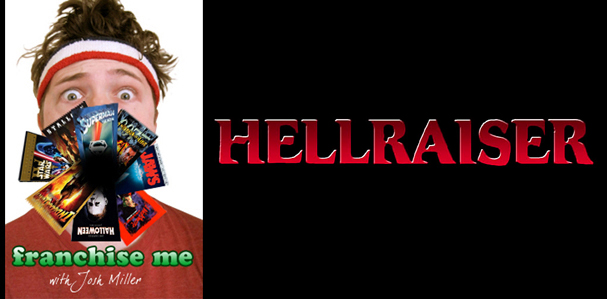
Hollywood loves a good franchise. The movie-going public does too. Horror, action, comedy, sci-fi, western, no genre is safe. And any film, no matter how seemingly stand-alone, conclusive, or inappropriate to sequel, could generate an expansive franchise. They are legion. We are surrounded. But a champion has risen from the rabble to defend us. Me. I have donned my sweats and taken up cinema’s gauntlet. Don’t try this at home. I am a professional.
Let’s be buddies on the Facebookz!
The Franchise: Hellraiser — concerning a supernatural puzzle box (and those humans foolish/unlucky enough to solve it) that opens a doorway to the hellish dimension of Pinhead, the most prominent member of the Cenobites, powerful beings who desire human souls for sadomasochistic experiments. Adapted from Clive Barker’s novella The Hellbound Heart, the franchise spans nine films, from 1987 to 2011.
previous installments
Hellraiser
Hellbound: Hellraiser II
Hellraiser III: Hell on Earth
The Installment: Hellraiser IV: Bloodline (1996)
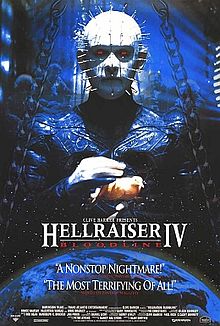
The Story:
The year is 2127! We begin in outer space, on a deserted and lonely space station, where Paul Merchant (Bruce Ramsay) is using a robotic avatar to open the Lament Configuration. He succeeds and Pinhead shows up, looking a little irked when he discovers he was summoned by a robot and is now trapped inside a vault. Before Paul can continue with his schemes, space cops (or something) show up and arrest Paul. In an interrogation cell, Paul tries to explain what the effing eff is going on to the unfortunately named female space cop/soldier Rimmer (Christine Harnos), and a narrative framing device is born! Then we jump back 400 years to un-bathed France, where Paul’s ancestor, the toymaker Philip L’Merchant (also Ramsay), is hired to build the Lament Configuration for a rich weirdo who uses it to summon the demon Angelique (Valentina Vargas). Some shit goes down, Philip dies, but his bloodline lives on inside his pregnant wife’s belly (where babies grow). Then we jump forward 200 years to Paul’s next relative, John (Ramsay once more), who is an architect and – oh snap – designed the puzzle box infused skyscraper seen at the end of Hellraiser III! Angelique is still around, she searches John out, Pinhead shows up, apparently the skyscraper is one giant puzzle box, more shit goes down, Pinhead defeated, blah blah, then we’re back to 2127 where the space cops must fight Pinhead and his goons, while Paul tries to convince Rimjob to let him finish his scheme to destroy Pinhead once and for all!
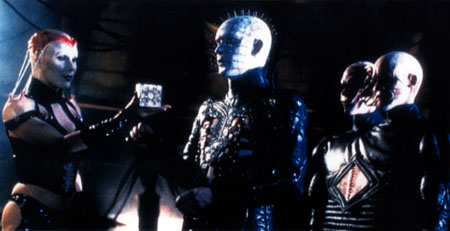
What Works:
You gotta give Bloodline this — it is thinking big. Three different time periods? That’s a bold narrative choice for a cheesy horror sequel. The space element is pretty stupid, but the inherent detachment from reality that comes with jumping into the future is at least paid off in the climax, when the space station is revealed to itself by an elaborate puzzle box. That’s cool. Or, well, coolish.
Bloodline‘s most commendable achievement is that it brings things back into focus after the gonzo derailment that was Hell on Earth. Top of the list: Pinhead is (mostly) restored to his former self. The wacky and overly animated prankster has left the building, and the regal and monotone British general is back. Doug Bradley’s voice is even pitched down in places once more, bringing back an other-wordly tone to Pinhead’s dialogue. He’s still not quite back to Hellraiser, but I’ve realized that if I’m going to make it through the next five films I’m just going to have to let that go and take what I can get. I’m just happy he isn’t maniacally laughing in every other scene anymore. The character needs to grow, I know, and as far as changes go, I enjoyed the relationship between Pinhead and Angelique. Their passive aggressive relationship – with Pinhead both revering and condescending Angelique – conjures impressions of Greek gods or scheming nobles (same thing really). We’ve yet to see Pinhead with any kind of social equal. He was very much the leader of his previous two packs, and Channard Cenobite killed Pinhead upon their first meeting, which gave the Cenobite world a decidedly anarchic feel. Really, Hellbound‘s glimpse of the Cenobite realm (I can’t bring myself to call it Hell) didn’t give of any impression of what life was like for the Cenobites. I like the idea of it being an S&M Olympus, with the higher Cenobites lazing in their pain-pleasures, somewhat bored, always waiting for chances to poke into our realm and get some new play things.
Generally speaking, if you’re doing a deep-in installment in a horror franchise, it isn’t a great idea to start mucking about in the backstory. If we’ve made it through four movies without caring about or needing to know certain things, you always risk stinking up the joint with pointless revelations, or worse, bed-shitting retconning. Bloodline finally delves into the backstory on the all-important puzzle box, and is mostly successful too. It was a clever idea to go back and see the creation of the Lament Configuration, and learn more about its creator, L’Merchant, who had been mentioned in Barker’s Hellbound Heart. I didn’t really love what we saw and learned, but on a conceptual level I’m all for it. Plus, it is funny seeing Adam Scott snoot around as a douchie Frenchman. Mickey Cottrell is also quite good as Duc de L’Isle, the black magic loving aristocrat who hires L’Merchant to build the Lament Configuration. And the scene in which L’Isle and Adam Scott’s character, Jacques, summon Angelique by skinning a peasant girl (Angelique then essentially inflating the girl’s emptied skin like a balloon) is coolly done.
The puzzle box skyscraper didn’t really make much sense as a coda to Hell on Earth, but it was a good gooser of a cliffhanger, and I like that Bloodline actually provides a totally logical explanation for it — I can tolerate L’Merchant’s descendent being drawn to the puzzle box far more than the idea that the box just draws any random slob to it like a siren call. And though we already got a taste of such ideas in Ghostbusters, I like the idea that someone has built an entire building that functions like a puzzle box. It also provides a good goal for our two Cenobites, as the building is the execution of L’Merchant’s Elysium Configuration, that was designed to destroy Cenobites but which Pinhead and Angelique want to use to permanently open the doorway between our worlds.
The sequence with the two identical twin security guards is quite fun, and their transformation into new Cenobites is no where near as egregious any what we saw in Hell on Earth; their final look is more in keeping with the designs of the original Cenobites in Hellraiser. There is no, “Oh, you guys carry flashlights? Well guess what? Now y’all got some flashlights in your faces! And you can shoot death rays from your faces too!” And I like that we actually get to see them transformed into Cenobites, instead of them just showing up all Cenobitten in a later scene. Angelique’s peeled back scalp Cenobite look is a good classic design too.
Pinhead’s hell hound is a spiffy idea for mixing things up with the Cenboites. Plus its design is great. It suits Pinhead to have a dog.
As we know, the continuity on the Lament Configuration has been somewhat wonky from film to film. In Hellraiser it seemed to be expressly controlled and owned by the old Chinese man Frank bought it from, considering the box was saved from a fire by that bone demon and returned to the man at the end of the film, to be given to a new victim. If nothing else, the Chinese man was certainly the box’s guardian and administrator. Ignoring the fact that this character never appears again, everything we’re shown in the first film implies that this box if very important; something further stressed in Hell on Earth as Pinhead’s entire goal is to destroy it. But what of all those extra boxes that Channard has? In Bloodline we are told that after L’Merchant’s death Angelique had several other puzzle boxes made from L’Merchant’s design. So, from this, if we wanted to, we could extrapolate that maybe none of these other puzzle boxes worked, lacking L’Merchant’s special touch. This is a stretch, and doesn’t really patch up all we see in Hellbound, but I at least appreciate Bloodline making an attempt to smooth out the continuity. After all, though Angelique apparently commissioned several more boxes, she still travels all the way to America to uncover the Lament Configuration from the skyscraper’s foundation where Joey hid it in Hell on Earth.
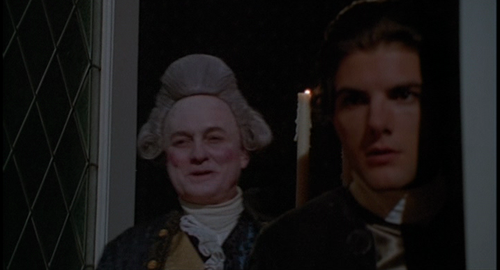
What Doesn’t Work:
Bloodline is more respectable than Hell on Earth, but, sadly, it is also less entertaining to watch. I wouldn’t call the film boring, but I was never that engaged with what was happening. The culprit, I think, is having one too many time periods. Three is a solid number, but at 86 minutes we don’t get to spend enough time in with any of the three incarnations of Bruce Ramsay to genuinely give a shit. This is especially felt with John Merchant, who I think should have been primary protagonist of the film.
Normally I wouldn’t talk much (if at all) about deleted scenes, but it is relevant here because I would otherwise still be complaining about the logic hiccups that occur because of all the cutting and alterations — Chucky FX creator Kevin Yagher apparently walked off the film during production over creative issues (hence the Alan Smithee director credit), and Joe Chappelle was brought in to finish the film, notably turning the 2127 Paul stuff into a framing device. Most of the logic problems happen in the L’Merchant section. Duc de L’Isle needs the Lament Configuration in his ceremony to summon Angelique. Okay, that makes sense. But then during the ceremony he sets the puzzle box on a table and repeats the same chant endlessly. So… why is it a puzzle box if no one is going to solve it? Or even touch it? (It was not originally used in the ceremony at all; the ceremony was the film’s opening scene.) And despite L’Merchant telling us that Angelique must serve whoever summoned her, later Jacques is suddenly her master. (Originally there was a whole bunch of shit involving L’Isle getting killed, Angelique being banished, and Jacques summoning her again.)
The most undercooked segment of this too brief film is the middle John Merchant section. Most of the problems I have here stem simply from the fact that I didn’t care about any of the characters – as we already know this is merely a stepping stone leading up to a finale in 2127 – so the pivotal kidnapping of John’s son didn’t offer as much drama as it was supposed to. We already know that these people, and whatever happens to them, good or bad, is inconsequential; it doesn’t help that the kid is stupid looking. But I could tread through this as Episode 2 of an anthology, so it wasn’t a huge deal. The bigger issue is that it climaxes in nonsensical nothingness. For one thing, John has apparently designed this crazy building puzzle box, which is entirely represented by some uncool junky moving-artwork hanging in a single room. This would be passable on an episode of Dr. Who but is a huge let down in a theatrical motion picture. Plus, none of it makes any sense. John is controlling the “puzzle” using a computer, but he might as well have been controlling it by eating a sandwich or picking his nose, for how well I grasped what the hell he was doing. I have even less of an idea what precisely went down at the end when John’s wife defeats Pinhead. The Cenobites are very easily thwarted when the story calls for it. Most egregious of this is when the wife banishes Pinhead’s hell hound by simply pointing the puzzle box at it and pushing the center circle. What the fuck is that shit? She didn’t even know what the puzzle box was or how to work it. If it was that intuitively easy to get rid of the Cenobites, how do they capture anyone?
I think the film would’ve been better served if the 2127 stuff had been merely book ends and nothing more. After Paul finishes telling Rimjob about his ancestors’ Cenobite encounters we then permanently settle into the future, as all the space cops are bumped off by Pinhead and friends, one by one. Sure we get some more kills, but considering that all this nonsense comes at the expense of the rest of the narrative, I didn’t especially appreciate any of it. Ideally, I would’ve preferred no 2127 whatsoever, not even as book ends; keeping the climax with John and making a bigger production out of the puzzle skyscraper. Jumping into the distant future in a horror sequel is hard to do as anything other than a knowingly stupid joke. The spaceship puzzle box is cool, but I would gladly trade it for a more satisfying film.
This is the first film in the franchise in which humans kill Cenobites on Earth. Ignoring the fact that the Cenobites were temporaily foiled by mundane things such as falling debris during the awful climax of Hellraiser, previously our heroes’ only coarse of action when defeating the Cenobites was to send them back to their realm using the puzzle box. But Rimjob uses the space station’s airlock to explode Pinhead’s hell hound. This raises some red flags. It also, weirdly, undermines the whole point of Paul’s puzzle box space station, which is meant to destroy Pinhead using the purifying power of sunlight (that doesn’t really make any more sense, but it sounds like it does at least). Is the hell hound a lesser Cenobite? And thus killable? Cause one would imagine that Cenobites could survive in the vacuum of space. What the fuck Bloodline? Explain yourself!
A key to Pinhead’s greatness is his amazing dialogue. This was of course going to sag the further Clive Barker got from the scripts. But it is sorely felt. It seems like the filmmakers are increasingly losing site of what the Cenobites are all about (in numerous ways). “Pain” and “flesh” are just kinda thrown around now, with little true context or weight. The feeling that the Cenobites are concerned with a sensation that is beyond pain and pleasure and thus fused indivisibly is completely absent. Now it just seems like they want to cause pain. Pinhead’s dialogue used to make him seem frighteningly unknowable, in a Lovecraftian sense. Now he just sounds like a scary version of Gomez Addams, talking about bad shit but meaning it in a good way personally. There are still good Pinhead lines now and then, but generally they are buried in larger crappy speeches.
This is kind of an unfair criticism, but I didn’t like that L’Merchant didn’t design the box himself. I say unfair because the way it is presented works just fine for Bloodline‘s story, and is sort of the whole point — that the Merchant bloodline was accidentally and tragically damned, which is Paul’s motivation for seeking out and killing Pinhead; he wants to salvage the bloodline. But it felt boringly safe for the franchise. I would’ve much rather gotten inside the head of a man who constructs a crazy toy to extend his own twisted pleasures. It also raises the question of what’s so special about L’Merchant? If L’Isle designed the Lament Configuration he seems like way more of a badass and more interesting of a character than L’Merchant. I guess it’s realistic that he lacked the skill to build the puzzle box himself, but this is a movie. In any case, generally the credited and famous person is the one who designed ____, not the one who did the labor. Following this theme, shouldn’t John Merchant have been the construction supervisor on the Elysium Configuration skyscraper instead of the architect? Ah, but that would’ve been stupid. Hence my point. L’Merchant should’ve been evil, and John Merchant should’ve been good, making bloodline amends.
Btw: according to the interwebs, Guillermo del Toro almost directed this film. Alas. Add that to the same list as Peter Jackson’s insane sounding Nightmare on Elm St 6 as sequels that could’ve been.
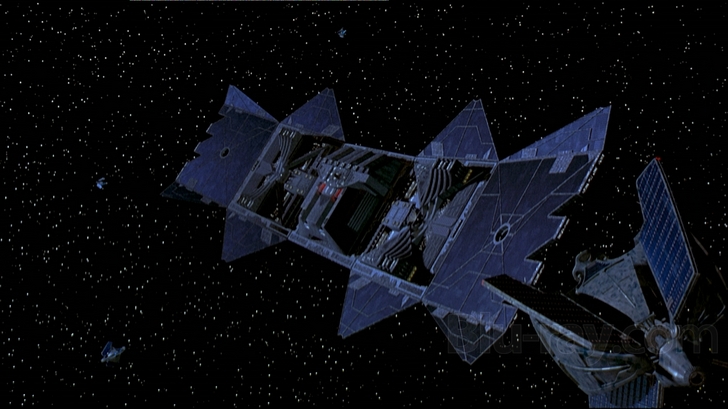
Overall Body Count: 12
Best Kill: John Merchant may be boring and have a boring storyline, but his death is awesome — in which what is essentially a grappling hook is shot through his neck, then retract, decapitating him.
Best Cenobite That Isn’t Pinhead: Hell hound.
Best Badass Pinhead Line: In response to being asked what he has faith in. “Nothing. I am so exquisitely empty.”
Best Whimsical Pinhead Line: In response to John Merchant saying “For god’s sake.” “Do I look like someone who cares about what God thinks? ”
Stupidest Pinhead Line: “What you think of as pain is a shadow. Pain has a face. Allow me to show it to you. Gentlemen, I am pain.”
Most Unpleasant Moment: The truly embarrassing CG we see when Paul Merchant is using his robot avatar to solve the puzzle box.
Should There Have Been a Sequel: Now would’ve been a great time to stop. Sigh.
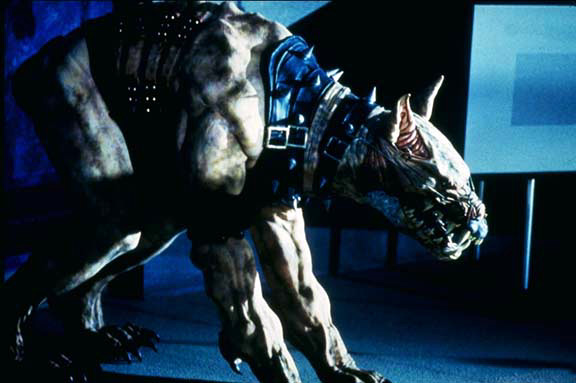
Up Next: Hellraiser: Inferno
previous franchises battled
Critters
Death Wish
Leprechaun
Phantasm
Planet of the Apes
Police Academy
Rambo
Tremors